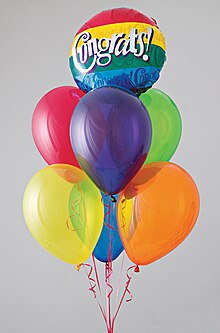This article needs additional citations for verification. (February 2022) |

A balloon is a flexible membrane bag that can be inflated with a gas, such as helium, hydrogen, nitrous oxide, oxygen, or air. For special purposes, balloons can be filled with smoke, liquid water, granular media (e.g. sand, flour or rice), or light sources. Modern day balloons are made from materials such as rubber, latex, polychloroprene, or a nylon fabric, and can come in many different colors. Some early balloons were made of dried animal bladders, such as the pig bladder. Some balloons are used for decorative purposes or entertaining purposes, while others are used for practical purposes such as meteorology, medical treatment, military defense, or transportation. A balloon's properties, including its low density and low cost, have led to a wide range of applications.
The rubber balloon was invented by Michael Faraday in 1824, during experiments with various gases. He invented them for use in the lab.[1][2]
- ^ Swain, Heather (2010). Make These Toys: 101 Clever Creations Using Everyday Items. Penguin Publishing Group. pp. 15–. ISBN 978-1-101-18873-6. Archived from the original on November 27, 2017.
- ^ "Balloons". Association of Science and Technology Centers, Vancouver, British Columbia. Retrieved September 30, 2024.
The first rubber balloons were made by Professor Michael Faraday in 1824 for use in his experiments with hydrogen, at the Royal Institution of Great Britain in London.